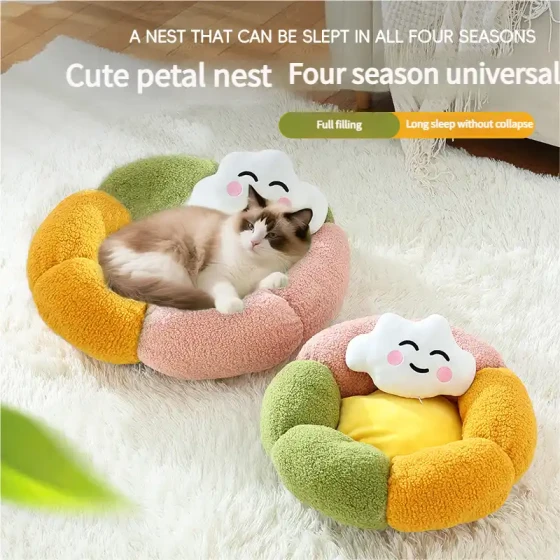The Difference Between Real Bites and Fake Bites in Cats_How to Distinguish Playful and Aggressive Cat Behaviors
Cat biting behavior often confuses many cat owners, unsure whether the cat is playing or truly angry. Simply put, to determine if a cat is giving a real bite or a fake bite, mainly observe bite force, body language, and the context. Playful "fake bites" are usually gentle, do not break the skin, and come with a relaxed body; while aggressive "real bites" are forceful, can cause scratches or wounds, and the cat’s body shows obvious tension and defensive signals.

As natural hunters, cats have innate behaviors of biting and pouncing. Kittens learn to control their bite strength and claws through play and roughhousing with companions, known as the socialization process. However, if cats lack proper guidance during growth or feel stressed, scared, or in pain for some reason, their biting behavior may shift from playful to aggressive. Understanding this distinction not only helps us interact better with our cats but also helps identify and solve potential problems in time.
Playful "Fake Bites" in Cats: Is It Affection or Testing?
When cats are relaxed and happy, they may show a series of seemingly aggressive behaviors, but this is actually their way of playing. These "fake bites" usually have these characteristics:
- Gentle bite force: They gently hold your finger or arm with their teeth, sometimes wrapping their front paws around your hand, but rarely enough to cause pain or break the skin. It’s like a human lightly "nibbling" a loved one, a sign of affection.
- Accompanied by relaxed body language: A playful cat’s body is usually relaxed, ears may face forward or be in a natural position, eyes may be half-closed or pupils normal sized. Their tail may sway lightly, but not twitch rapidly and tensely. Sometimes they purr, indicating they are happy.
- Usually occurs during interaction: This behavior often happens when you interact with them using your hands or toys, or when you pet them, making them feel very comfortable.
Imagine when you play with your cat, it suddenly pounces, "attacks" your hand with mouth and paws, but quickly lets go, then wags its tail, ready for the next "attack"—this is mostly play.
Aggressive "Real Bites" in Cats: Warning Signals to Watch Out For!
Unlike playful "fake bites," aggressive "real bites" are a warning signal from the cat indicating it feels threatened, in pain, or extremely uneasy. This biting behavior is serious and requires immediate attention.
- Strong bite force that can cause injury: Aggressive bites are very forceful, enough to pierce the skin, cause bleeding, or even more serious wounds. Biting may be accompanied by scratching, a full-hearted "attack."
- Accompanied by tense and defensive body language: Before or during an attack, cats send clear signals. For example, ears pinned back or flattened to the sides, pupils suddenly dilated (even in bright light), fur standing up, body stiff or arched. They may hiss, growl, or make low rumbling sounds. The tail may twitch rapidly and tensely side to side.
- Possible causes: Aggressive biting may have various triggers, like fear (e.g., cornered), pain (e.g., you touch an injured area), territoriality (feeling you invade their space), overstimulation (biting suddenly during petting, possibly because some spot feels uncomfortable), or redirected aggression (taking out anger on you after seeing another cat outside).
If your cat suddenly bites you accompanied by hissing or pinned back ears, you should immediately stop interaction and give it space to calm down.
How to Distinguish: Details Are Key
Distinguishing between playful and aggressive cat behaviors depends on observing details and understanding their signals:
- Look at bite force: This is the most direct difference. Gentle, non-injurious bites usually mean play; forceful, painful or injurious bites mean aggression.
- Observe body language: Relaxed body, lightly wagging tail, normal ears and pupils indicate play; tense body, airplane ears, dilated pupils, hissing or growling indicate aggression.
- Consider context: Does the bite occur during intense play, or when the cat is forcibly held or undergoing disliked care (e.g., nail clipping, medication)? The context gives many clues.
- Listen to sounds: Cats may purr or make soft noises when playing; aggressive cats may hiss, growl, or make low rumbling noises.
Just as humans blush and clench fists when angry, cats have their own set of emotional body language. Learning to "read" these signals helps you better understand their intentions.
How to Respond to Different Types of Biting Behavior
After understanding the difference, naturally the response methods vary:
- Responding to playful bites: If a cat playfully bites too hard or you want to prevent it from developing a hand-biting habit, immediately stop interaction, make a short "ouch" or a low "no," then walk away and ignore it for a few minutes. This teaches the cat that biting ends the game. Meanwhile, provide plenty of toys (wand toys, small balls, etc.) to channel its energy onto toys instead of your hands.
- Responding to aggressive bites: If the cat shows aggression signals and bites, do not punish or yell as this may increase fear or agitation. Immediately stop interaction, slowly move your hand or body away, and give it enough space. If possible, quietly leave to let it calm down. If aggressive bites happen frequently or without obvious cause, consult a veterinarian or professional animal behaviorist to rule out health issues or seek behavior correction advice.
Frequently Asked Questions
- Why does my cat like to bite my hands and feet?
It may be because it perceives your hands and feet as moving prey, triggering its hunting instinct, especially when it is a kitten. It might also be bored and trying to get your attention. - Why does my cat suddenly bite me while licking?
This is called "petting-induced aggression." After being petted to some extent, the cat may become overstimulated or feel discomfort in a certain area and suddenly shift mood, biting to say "enough." Watch its body language, and stop petting immediately if the tail twitches rapidly or ears flatten back. - How to prevent my cat from biting?
Provide ample daily exercise opportunities (e.g., 15-20 minutes of play daily), enrich the environment (cat trees, puzzle feeders), establish proper play habits from kittenhood, and do not use your hands directly when playing — use toys instead. Also, understanding and respecting individual differences and emotional signals of cats is very important.
Conclusion
In short, distinguishing a cat’s real bite from a fake bite is not just about whether it bites you, but involves considering bite force, body language, and context. Play bites are a way cats express friendliness and play, usually harmless; aggressive bites signal distress or warning. As responsible cat owners, learning to understand cats’ body language, patiently guiding and fulfilling their needs can help build a more harmonious and closer relationship with our furry friends. Remember, every cat is an independent individual with unique ways of expressing emotions. The more you observe and learn, the more you become a better "cat language speaker."


-560x560.webp)


